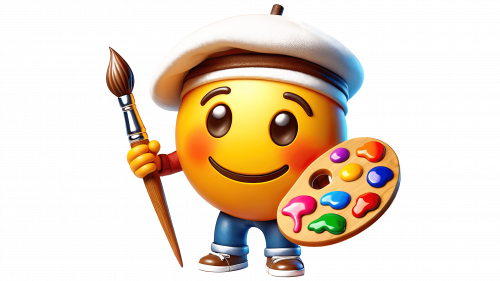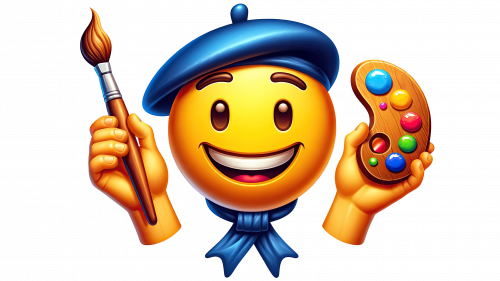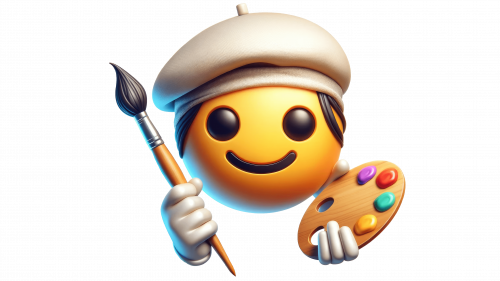In today’s digital era, using emojis in our everyday interactions has become commonplace. These colorful symbols enhance our online conversations by adding a layer of emotional expression that often goes beyond the capacity of mere words. Serving as virtual emotional cues, they play a crucial role in making our intentions and sentiments clear, especially when plain text might leave room for misunderstanding.
The emoji universe is vast and ever-evolving. Ranging from basic smileys to intricate and symbolic representations, this spectrum provides a multitude of options for users to accurately mirror their emotional responses or thoughts in response to a message. In recent times, the cultural significance of emoji has grown, leading to their recognition as a form of modern art.
Meaning and use of the Art Emoji
Emojis, once viewed as mere playful icons, have evolved into significant cultural symbols, marking a pivotal shift in the landscape of written communication. Throughout history, art has served as a powerful conduit connecting the tangible world with the realm of human creativity. It has continuously echoed the sentiments, events, and zeitgeist of its era, evolving from primitive cave paintings to elaborate oil canvases and, ultimately, to contemporary digital platforms. In this trajectory of artistic evolution, emojis have emerged as a contemporary form of expression, marrying art with digital communication.
Echoing historical masterpieces, some emojis draw direct inspiration from iconic artworks, such as the emoji reminiscent of Edvard Munch’s “The Scream” or the wave emoji that parallels Katsushika Hokusai’s “The Great Wave off Kanagawa.” These digital symbols are not mere whimsical creations but embody a deeper artistic lineage.
The significance of emojis was cemented in 2016 when a Japanese telecommunications company donated a collection of 176 emojis, originally designed in 1999, to the Museum of Modern Art in New York. This gesture underscored the cultural and artistic value of emojis. The same year, the museum curated an exhibition showcasing the evolution of emoji, highlighting their journey from niche Japanese icons to global digital vernacular.
Initially popularized in Japan, emojis gained worldwide prominence after their incorporation into the Unicode standard in 2010. This integration facilitated their global dispersion, enabling diverse expressions ranging from emotions and weather to animals and astrological signs. Today, emojis are not just digital accessories; they are a testament to the ever-evolving narrative of human expression and artistic innovation in the digital age.
Emojis are often used in the context of art, creativity, and cultural events. They can express an interest in art, indicate a profession or hobby related to art, or simply add a creative touch to messages and posts on social media. Here are some examples of emojis that fall under the “Art Emoji” category:
🎨 – This emoji usually signifies “art” or “painting.” It is used to denote creative activities or artistic events.
🖼️ – Represents a painting or artwork, often used to indicate galleries, museums, or artistic themes.
🖌️ – A paintbrush symbolizing the process of creating art, drawing, or painting.
🖍️ – A colored pencil or crayon, typically associated with children’s creativity or the drawing process.
📐 – A set square or angle, often used in the context of architecture or design.
🎭 – Theater masks symbolize dramatic arts, theater, and other performing arts.
🎬 – A clapboard representing cinematography or movie production.
Final thoughts
Emoji transcend their role as mere digital symbols, evolving into a medium for artistic creation. Rapper Yung Jake exemplifies this, crafting celebrity portraits entirely from emojis, garnering widespread acclaim. This innovative use of emojis has inspired the development of online tools that transform conventional images into emoji-based art.
Moreover, emojis have found a unique niche in articulating art itself. Classic artworks like Vincent van Gogh’s “Starry Night” and Salvador Dali’s “The Persistence of Memory” are now expressible through simple emoji sequences, such as 🌌🌟🌀 and ⏳🕰️, respectively. This novel approach extends beyond visual arts; literary phrases and even entire books are being reinterpreted in the versatile language of emojis. This fusion of emojis in representing and recreating art forms a distinct and modern genre, aptly termed “Emoji Art.”





